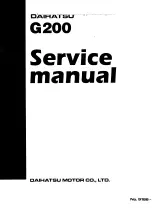
3.3.3 System Working Principle
3.3.3.1 Shifting Working Principle
Because the engine output torque and speed range is relatively
narrow, unable to meet the complex requirements of the
vehicle under the conditions of a big range of traction and
speed changes, the role of transmission is to expand the driving
wheel torque and speed range by changing the transmission
ratio, therefore to adapt to constantly changing conditions.
This vehicle's transmission is a five-speed manual
transmission with two axles. There are five forward gears, a
reverse gear, and a neutral gear. Gear shift control is achieved
by controlling the shift shaft. The shift shaft and the shift fork
make the selected synchronizer and gear mesh. The input
shaft torque and speed is delivered to the main shaft, to the
differential, and to the drive axle and wheels.
Neutral Gear Working Status:
FE03-2002b
The shift control does shift the shift shaft and the shift fork.
Synchronizer and the neutral gear are not meshing. Reverse
idler wheel and the input shaft reverse gear and main shaft
output gear are not mesh, No main shaft torque and speed
output.
Reverse
Reverse Gear Working Status:
FE03-2003b
The shift control makes the 5th/Reverse shift shaft and fork
move to rear end of the transmission. Reverse idler wheel and
the input shaft reverse gear and main shaft output gear are
meshing. Main shaft input and output torque and speed is the
same direction.
Transmission / Drive Axle
Manual Transmission
3-31
EC718/EC718RV EC715/EC715RV 10/2009
Summary of Contents for EC715 2009
Page 4: ......
Page 330: ...Next Step 10 End 2 248 Fuel System JL4G18 D Engine EC718 EC718RV EC715 EC715RV 10 2009 ...
Page 1164: ......
Page 2008: ......
















































